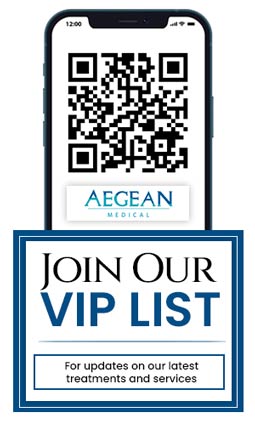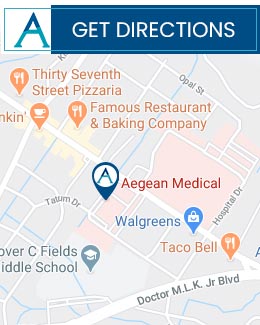Fat Transfer Breast Augmentation Specialist in New Bern, NC
Fat transfer breast augmentation is a cosmetic procedure that has gained popularity in recent years due to its natural-looking results and minimal scarring compared to traditional breast implants. This procedure involves the extraction of fat from donor sites through liposuction, purification of the fat cells, and then injecting the purified fat into the breasts. Visit Aegean Medical today. For more information, contact us today or book an appointment. We are conveniently located at 2111 Neuse Blvd, Suite J, New Bern, NC 28560.




Table of Contents:
What is fat transfer breast augmentation?
How long does a fat transfer breast augmentation last?
What are the benefits of fat transfer breast augmentation?
What is recovery like after a fat transfer breast augmentation?
Fat transfer breast augmentation begins with the extraction of fat from donor sites using liposuction. This technique involves making small incisions in the donor areas, such as the abdomen, thighs, or buttocks, and inserting a thin tube called a cannula to suction out the excess fat. The harvested fat is then processed to isolate viable fat cells. This purification process ensures that only the healthy and intact fat cells are used for the augmentation procedure. Once the fat cells are purified, they are injected into the breasts using a specialized injection technique. The surgeon carefully places the fat cells in multiple layers, ensuring an even distribution and natural-looking result. This technique allows for precise control over the volume and shape of the breasts, resulting in a customized outcome that suits the patient’s desires.
One of the main advantages of fat transfer breast augmentation is the use of the patient’s own fat, which leads to natural-looking results. Since the fat cells come from the patient’s own body, they integrate seamlessly into the breast tissue, creating a more natural appearance and feel compared to traditional implants. Additionally, the use of the patient’s own fat reduces the risk of allergic reactions or rejection. Another benefit of fat transfer breast augmentation is the minimal scarring. Unlike traditional breast implants that require incisions and placement of implants, fat transfer involves small incisions for liposuction and injection, resulting in less visible scars. This is particularly appealing for individuals who are concerned about the long-term visibility of scars. Furthermore, fat transfer breast augmentation can also provide improvement in body contouring in the donor sites. By removing excess fat from areas such as the abdomen or thighs, patients can achieve a more balanced and proportionate figure. This dual benefit of breast augmentation and body contouring makes fat transfer an attractive option for those seeking overall aesthetic enhancement.
While fat transfer breast augmentation offers numerous benefits, it is important to consider the potential risks and complications associated with the procedure. One of the main concerns is the possibility of fat absorption and volume loss in the breasts over time. Not all of the transferred fat cells survive in their new location, and some may be absorbed by the body. This can lead to a decrease in breast volume, requiring additional procedures to maintain the desired results. There is also a risk of infection or complications at both the donor and recipient sites. Proper sterilization techniques and post-operative care are crucial to minimize these risks. It is essential to choose a qualified and experienced surgeon who is well-versed in fat transfer breast augmentation to ensure optimal results and safety.
Breast augmentation has long been a popular cosmetic procedure among women seeking to enhance their physical appearance. While traditional breast implants have been the go-to option for many years, a newer technique known as fat transfer breast augmentation has gained significant attention. This procedure involves the use of a patient’s own fat, collected through liposuction, to enhance the size and shape of the breasts.
The effect of fat transfer breast augmentation is lifelong. It can take up to six months to get results. During this time, fat cells colonize their new location and remain there for life.
Fat transfer breast augmentation begins with the collection of fat from other parts of the patient’s body, typically the abdomen, thighs, or buttocks, through liposuction. This allows for the dual benefit of removing unwanted fat from these areas while simultaneously enhancing the size and shape of the breasts. Once the fat is collected, it undergoes a purification and processing phase to ensure that only the highest quality fat cells are used for transplantation. This involves separating the fat cells from any impurities or fluids, resulting in a concentrated solution of pure fat. Finally, the purified fat is injected into the breasts using small, strategically placed incisions. This allows for precise placement and sculpting, resulting in a more natural and aesthetically pleasing outcome.
One of the key advantages of fat transfer breast augmentation is the natural and long-lasting results it offers compared to traditional implants. Since the procedure uses a patient’s own fat, the end result is a more natural look and feel, as the fat integrates seamlessly with the existing breast tissue. Additionally, the results of fat transfer breast augmentation tend to be long-lasting, with studies showing that the majority of patients retain their enhanced breast size and shape for several years. Another benefit of this procedure is the reduction in unwanted fat from the donor sites. This provides patients with the added advantage of body contouring, as they can achieve a slimmer and more sculpted appearance in areas such as the abdomen or thighs.
While fat transfer breast augmentation offers numerous advantages, it is important to consider certain limitations. One such limitation is the limited increase in breast size that can be achieved compared to traditional implants. While implants can provide a more significant increase in cup size, fat transfer augmentation is generally more suitable for patients looking for a more subtle enhancement. Additionally, the success of the procedure relies on the availability of sufficient donor fat. Patients with limited fat reserves may not be suitable candidates for this procedure. Finally, it is important to note that there is a possibility of fat absorption or loss over time. While the majority of the transplanted fat cells survive and integrate with the breast tissue, a small percentage may be reabsorbed by the body. This may result in a slight reduction in breast size, which can be addressed through additional treatments or touch-ups if desired.
This takes about three weeks. However, it is strongly recommended that you wear your surgeon’s recommended sports bra day and night for the first month postoperatively and during the day for the first three months postoperatively.
Swelling and bruising with expected discomfort that subsides within 3 weeks. Paracetamol should provide adequate analgesia. All sutures are removed after 7-10 days.
Certain areas of the breast may feel tight or even tender for several months. This can lead to deep bruising and slower fat absorption.
You can work from home within a few days and drive to work within 3-7 days. Moderate physical activity within 3 weeks and vigorous physical activity within 3 months.
One of the greatest advantages of this type of breast augmentation is that the results are permanent. Once the transferred fat cells are fully anchored in the breast tissue, they remain for life and usually do not require additional fat transfer. We serve patients from New Bern NC, Hymans NC, River Bend NC, Brices Creek NC, Fairfield Harbour NC, and Neuse Forest.

Check Out Our 5 Star Reviews






